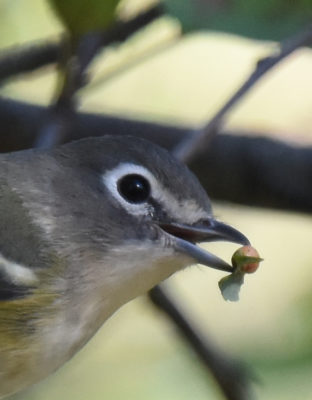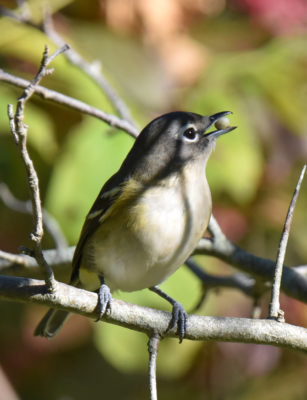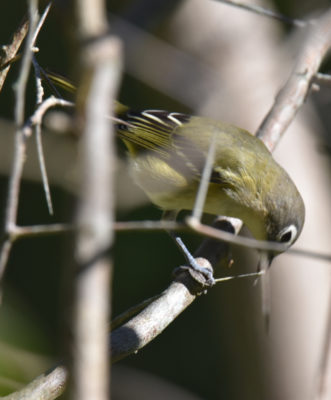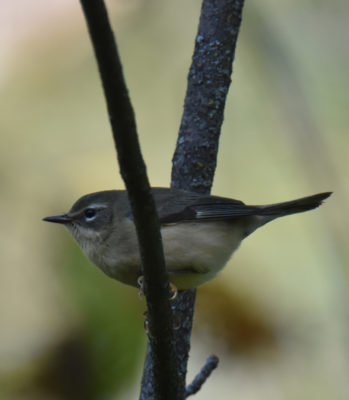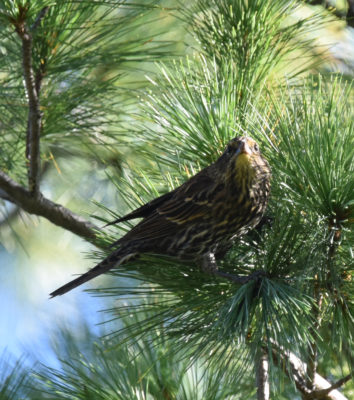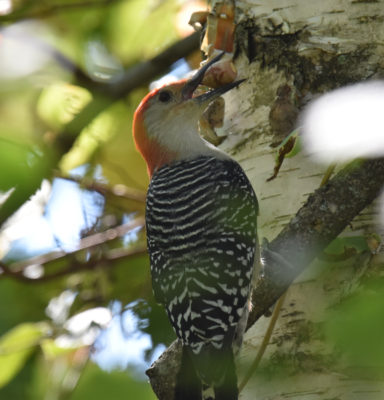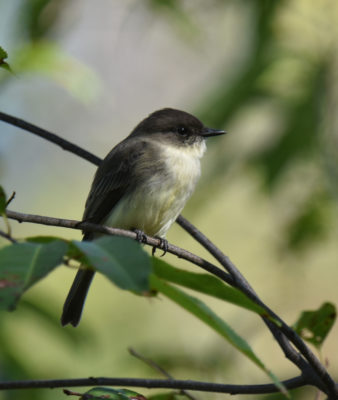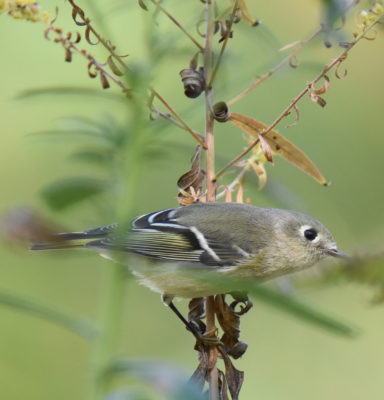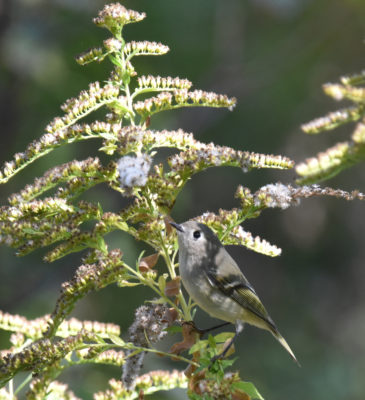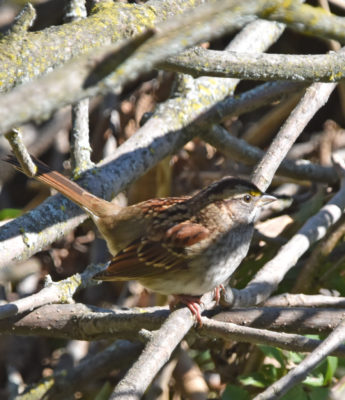I often meet other walkers interested in birds and photography when I’m prowling through the city parks in southern Ontario. A common complaint is that the park trails are “too busy” and there are no birds. Personally, I rarely find that’s true but I do think it takes much more time and patience to get a rewarding closeup view of a bird when the trails are echoing with the excited shouts of young explorers, the thumping chirping sounds of runners and their overflowing earbuds, and the explosion of barks when dogs unexpectedly encounter each other. For me, it’s great to see so many people enjoying their local parks: it makes it safer for me and keeps the cities interested in maintaining and expanding their park systems to the benefit of all including the birds!
Here are some of the creatures I met on today’s ramble through the Rattray Marsh on a cool, sunny first day of October.
A Migrating Blue-headed Vireo Loads Up on Protein and Carbs
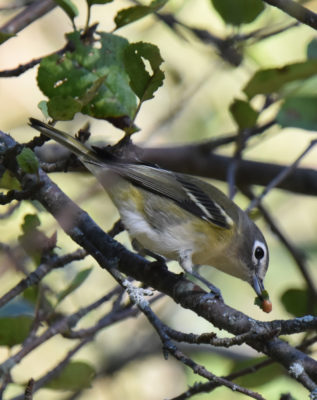
This Blue-headed or Solitary Vireo landed in a shrub right beside the Old Poplar spur path. It had found something reddish to eat.
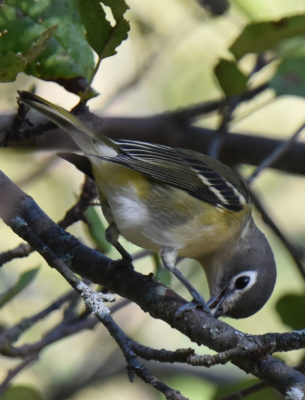
It poked at the object holding it steady against a branch several times before it finished with it.
To me, it looks attached to the leaves. It may be a gall caused by an insect, in which case the Vireo probably pried it open and ate the critter inside. (If you have another guess, please share it with a comment.)
Its next snack was easier to identify: it’s a Dogwood berry from one of the shrubs it was hunting through.
Next, it caught an insect. It seemed to be hard-shelled, long legged and fairly flat. It reminded me of a dragonfly nymph and a cicada but didn’t look exactly like either. The Vireo took a minute of moving it around and pinching it against the branch before eating it.
Whatever it was, it was stretchy!
During the five minutes that the Vireo stayed beside the path, I saw it find and eat these three snacks. It makes me wonder how much one small bird eats in an hour on migration.
Some Other Quick Sightings
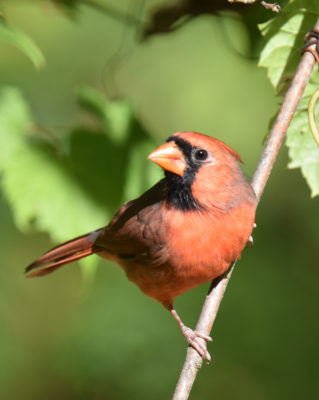
A pair of Cardinals were feeding a fledgling almost the same size as themselves. I wonder how many broods this pair raised this summer–possibly three?
A few warblers zipped past between pedestrian sightings. This Black-throated Blue is probably a first-year female. I also saw a warbler with a splash of yellow on the front but it vanished before I could see if it was a Nashville or a Common Yellowthroat or….
I’m not sure if the Red-winged Blackbirds in the pine tree were eating pine nuts out of the cones or catching insects or caterpillars. There were six or seven birds at the top of the tree.
Some October Insects
Not all of the insects I saw today were being eaten at the time.
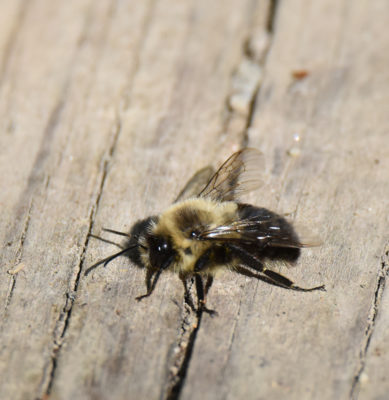
While a father with four children under four tried to keep all four moving past me, I took a time out to take a photo of this sleepy bee. Throughout the park I saw many bees resting almost in a stupor on plants and leaves.
I counted nine Monarchs, all in flight, as I walked around the loop.
I also saw one Mourning Cloak and two Polygonia, probably Eastern Commas.
The Regulars and Kinglets at the Rattray is Mississauga
The marsh itself hosted its usual contingent of Mallards, Gadwall, Mute Swans and Cormorants. I didn’t take any epic photos so you’ll have to imagine them.
Similarly, the trees provided perches for Downy and Hairy Woodpeckers, Robins, White-breasted Nuthatches, Chickadees and Goldfinches.
Many of the birds were “backlit” like this Ruby-crowned Kinglet making them easier to id by their behaviour than by their colouring. This little dude never stayed still and often hovered at the ends of branches to pick at things under the leaves–a clue that it may be a Kinglet.
Seeing this Red-bellied Woodpecker fly and land in a birch tree carrying an acorn made me curious. I wondered if they hide acorns for the winter. When I got home, I checked. Yep, they do store food including acorns for later use, according to the Cornell website.
Strategies Kinglets and Phoebes Use to Catch Insects
At one point I stopped to watch an Eastern Phoebe “flycatching.” It would perch, and turn its head various directions looking intently. Then it would swoop off to catch something, eat it, and land to start looking again. It usually preferred to perch nearish to the end of a branch and preferably on a bare bit of branch.
As you can imagine, this perching habit makes Phoebes popular with photographers!
Ruby-crowned Kinglets, on the other hand, work much harder for their catches. While hunting, they seem to be always on the move. As well as checking along branches and under leaves, they often hover at the tips of branches to get things off the undersides.
This was one of more than 4 Ruby-crowned Kinglets that were working there way through a patch of Goldenrod and shrubs.
For every photo I took of the Kinglets, I have two or three that only have the Goldenrod because the birds had moved on.
Heading South Quickly
The last group of birds I saw on my walk were a flock of White-throated Sparrows.
They tend to bring up the tail end of the Migration Parade, so I doubt I’ll be seeing very many warblers in two-weeks time. Still, there may be some other birds arriving to stay here in the Deep South for the winter. I always look forward to the chance of seeing Redpolls and Siskins.
Related Reading
- What Sparrow Has a Yellow Eyebrow?
- What Sparrow Has a Yellow and Black Beak?
- What Sparrow-like Bird Has a Reddish-Pink Chest?
Join In
Have you seen any migrants moving through your woods this week? Please share your sightings with a comment.

